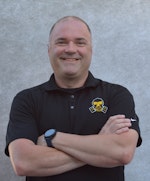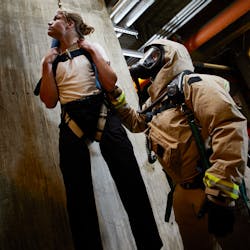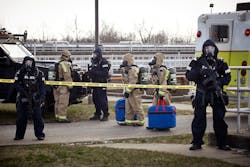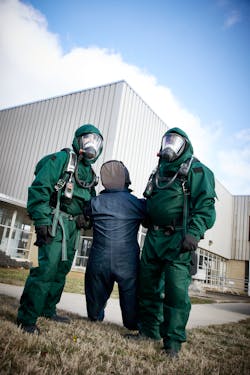Dressing in specialized chemical protective clothing (CPC) is a serious business. We are firm believers that this decision shouldn’t be taken lightly. So, through training, we address the issues that will arise, might arise and hopefully never arise. Like any piece of equipment that’s used in life-saving responses, firefighters who utilize this PPE need to be comfortable and proficient wearing and working in the MT94.
Understand the mission
When the task for the operations- or technician-level hazmat responder is to find the appropriate suit, one question that’s asked is, “What is my mission?” In the beginning stages of an incident, in which people possibly are injured and time is of the essence, this question seems like one that doesn’t fit the situation. The problem dictates the trajectory of an efficient and safe operation for everyone involved.
The mission can be described as an evaluation of several things, such as our training level, geographical location to the release, the number and severity of the patients, the chemical itself and the site of the release. A common question is, “When do we perform the 'wardrobe change'?” Primarily, the MT94 suit in the Type 1 and Type 2 configurations would be a “body moving” suit. If our mission, training and patient count justify this suit, then the choice is clear.
We prepare for this decision in training. As a well-rounded hazmat member, prepare for the eventuality of wearing PPE for a prolonged duration in a situation that isn’t meant for humans. This possibility is both mentally and physically stressful. That doesn’t mean that we can’t do it; it means that we must address all of the eventualities that one might encounter and prepare the operator to deal with them.
The training component that needs to be addressed is not only for the members who go downrange but also for supervisors and incident commanders. We have found through extensive training that, although a supervisor isn’t the one who performs the physical work of moving patients and addressing decontamination issues, the supervisors who are in the suit understand the mental and physical challenges that those members go through. The supervisors are more empathetic and mindful of the time and of the stresses that they are handling and of when to get out of the hot or warm zone.
Who uses the PPE?
Many of the personnel who will be on scene operating in either the warm or hot zone will be the operations level. It’s far easier to train members in 40 hours to a few mission-specific competencies than to teach the same number for the technician level. Many departments choose to have relatively few technicians who are exposed to more training and have more equipment and capabilities and outfit the operations levels with a more defined role.
In the operations level, NFPA designates a limited number of “Mission-Specific Competencies” that operations-level members can attain. There are a few requirements for members to be allowed to do them, though. In short, the department must train the member who is in the mission, ensure that the member is advised and understands the hazards in doing this job, and equip the member with the tools and PPE to do the job safely.
Product control
A common task for operations-level members is product control. Although we commonly think of the automobile that’s leaking gasoline and the application of absorbent, incidents might evolve beyond that point to something that’s in the air or that’s confined to a location that must be in the immediately dangerous to life and health (IDLH) area. Unfortunately, victims might be there, and operations members will be tasked to move them for life-saving efforts.
In this competency, product control might involve using foam, fans for ventilation of an enclosure or remote shut-offs to slow or stop the release.
Air monitoring and sampling
The most performed and trained on mission-specific competency for the operations member, air monitoring is in use for seemingly every unit in the field. The four-gas meter that is used for oxygen, hydrogen sulfide, carbon monoxide and LEL is the tool of choice. We do this with minimal PPE when a multitude of metering is needed, perhaps because of geographical difficulties, size of the location or compartmentalization of the area. We can suit operations members (assuming trained to wear CPC PPE) and have them assist technician-level members with more metering capabilities.
Mass decontamination
When a significant event occurs and quick decontamination of people is needed, we enter an evolving and contaminated environment. The thought that comes to mind is using two pumpers to create a corridor and have fog appliances to drench victims. What if it is January in the Northeast? Mass decontamination might have to take place in the lobby of a building, near the people who you are decontaminating. There will be overspray. The levels of contamination might not be low enough for regular PPE. That is where suits that are compliant with NFPA 1994: Standard on Protective Ensembles for First Responders to Hazardous Materials Emergencies and CBRN Terrorism Incidents, such as the MT94, come in.
Technical decontamination
We accomplish mass decon at a distance; technical decon undoubtedly is not. Depending on your method of decon—using dry or wet—you will be, at best, an arm's length away from responders or civilians who will be dirty.
Victim rescue and recovery
In our minds, victim rescue and recovery is the operation for which the MT94 is built. The ability to get into the suit with only a partner to zip you up and check your seal makes this realistic. Dramatically improved dexterity, hearing, vision and control allow members to make quick, decisive moves to effect life-saving actions. Through extensive training evaluations, we have found that members have a marked improvement in not only comfort but the duration of work time.
Training ideas
We would be remiss if we didn’t highlight a few methods, tips and tricks that you and your department could do to improve your abilities and train to be ready for a release.Dexterity drills: While in a suit, have a member do “simple” tasks, such as using a key to open a lock—but there are 30 keys on the ring —or assembling a bolt, washer and nut configuration. Doing these drills can be done with only the arms sections if you can claim them from an old suit that is being disposed.
Communication: Although the MT94 suit makes conversation markedly more comfortable than being in a Level A suit, communication still is a competency that should be mastered. Our favorite drill is dividing the crew in two. The “incident command” crew has a radio, pencil and paper. The other team will be in full CPC PPE and have a radio and a drawing. While the PPE crew is in another room, they must describe the shapes and configuration to incident command. The objective is to have both papers look the same. Pro tip: If you do this for multiple crews from the same original drawing, you could award a prize for the best and worst.
Air consumption: This personal development drill, which serves to calm an operator who is in the suit and under stress, is the knowledge of how much air that an operator has in his/her cylinder. This drill can be paired with the communication drill. Note the pressure that’s in the cylinder and mark down the time. Begin the communications drill, and when the low-air alarm begins, not the time, continue the exercise. Eventually, the alarm will stop. Note that time, too. Use the cylinder until the air stops. Use this information and check results doing various activities, such as walking. It’s eye-opening how much time is in the cylinder, which serves to make the operator situationally aware of his/her equipment and body.
Logistics management: Where we operate usually isn’t where we park. We need to practice how to move the needs to the deeds. All of this can be done in any stage of PPE dress (or lack thereof). Give a scenario and have members collaborate, find and move the equipment to a location that’s a short distance away. What typically is seen is that taking time to do this usually saves time in the long run. The goal is to be more efficient.
Emergency procedures: Although this topic currently is in a national debate (all of which is going in a positive direction), we are beginning to discuss the possibility of hazmat rapid intervention teams (RIT)/firefighter assist and search teams (FAST). This ensemble is very well-suited for hazmat RIT. Although the members who will be most affected by exposure will be at the point of release, the RIT team can be in visual distance, ready to act with the MT94 suit.
Another point of consideration (and in our opinion is a training gap), is that we all have practiced or conceptualized rescuing a member from a precarious position. How many of you have practiced being the victim? Do you believe that you can be more proactive in your evacuation? We aren’t saying that you should be ready to fail, but failing to prepare is preparing to fail. The time to come up with a plan isn’t when an incident occurs, but in training.
About the Authors
Bobby Salvesen is a 23-year veteran of FDNY. He has been assigned to Hazmat Company 1 for the past eight years. Salvesen studied chemistry at New York Institute of Technology and at SUNY-Westbury.
Michael Monaco is an 18-year veteran of FDNY. He has been assigned to Hazmat Company 1 for the past 15 years. Monaco holds a bachelor's degree in biochemistry. Salvesen and Monaco co-host “The Hazmat Guys” podcast which can be found at https://thehazmatguys.com/.

Bobby Salvesen
Bobby Salvesen retired in 2022 after more than 25 years of service with FDNY and Hazmat Co. 1. He is a Nassau County, NY, Fire Service Academy hazmat instructor and is co-host of The Haz Mat Guys podcast. Salvesen studied chemistry at New York Institute of Technology, SUNY-Old Westbury and SUNY-Empire State.
Michael Monaco
MICHAEL MONACO is an 18-year veteran of the FDNY. He has been assigned to Hazmat Company 1 for the past 15 years. Monaco holds a bachelor of science degree in biochemistry. Bobby Salvesen and Monaco co-host “The Hazmat Guys” podcast.








